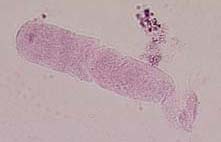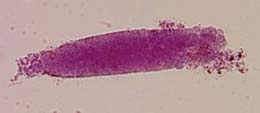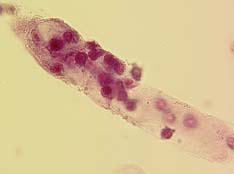Casts
Definition
Casts are urinary elements representing a cast of the light of renal tubules (distal tube or collector tube).

Histological section of waxy casts in a renal tubule
Casts are composed of a homogeneous matrix, i.e. uromoduline or Tamm-Horsfall mucoprotein, a large glycosylated polypeptide of 616 amino acids, 15-14 nm in diameter, 7x107 Da molecular weight (polymerized form) and containing 30% carbohydrates. This protein is produced in the ascending limb of the loop of Henle and in the proximal part of the distal tube. It consists of filaments which are gathered together in a network of irregular and three-dimensional meshes (elongated fishing net). The monomers aggregate and disintegrate depending on the pH and ionic strength. This is one of the few proteins that are produced by the kidneys and excreted in urine. It is the dominant protein in normal urine with a normal excretion of 50-100mg/d. It is partially reabsorbed by the kidney: its concentration in plasma is 50-350 μg/L. Its physiological role and regulatory mechanism are not well known. It certainly plays a role in the transport of sodium, in the regulation of water reabsorption, and in protection against bacteria in the tubular epithelium.
Cellular elements (erythrocytes, leukocytes, kidney epithelial cells) and plasma proteins can be incorporated or mixed with Tamm-Horsfall protein. Casts of various widths and lengths are observed.The width depends on the diameter of the renal tubule from which the cast originates.
Casts are perhaps the elements of urinary sediment that play the most important role in the clinical diagnosis of kidney disease.
Three types of casts can be distinguished:
1. Mucous or hyaline casts:
Their main component is the Tamm-Horsfall mucoprotein .

2. Waxy or granular casts composed of plasmatic proteins:
The proteins are mainly the result of glomerular filtration but also of tubular secretion

3. Cellular casts:
Their main components are cells -erythrocytes, leukocytes or renal cells - incorporated into the Tamm-Horsfall mucoprotein.
